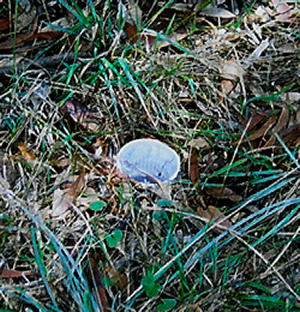
Pitfall trap.
Pitfall Traps
Pitfall traps can be a useful technique for collecting Argentine ants. In fact, in some circumstances pitfall traps may be better than direct searching, or using baits. Pitfall trapping involves digging a small plastic cup into the ground, so the open lip of the cup is level with the ground. As ants (and other invertebrates) run along the ground they fall into the cup and cannot get out. A preservative of ethanol:gylcol mix (50:50, or 75:25) is used to kill invertebrates, preserve them from rotting, and prevent them from crawling out of the cup. A few drops of fish oil should be placed into pitfalls traps; this increases attractiveness to Argentine ants.
Cups used need to be plastic (to avoid them breaking) but can range in diameter from 3 cm to 10 cm. Cups need to be able to have a lid placed on them, for transporting back to the laboratory. Pitfall traps are usually spaced about 5–10 m apart. Pitfalls traps should be left out ideally for 4 weeks (but can be left out for shorter periods). The chances of detecting Argentine ants increases with increasing duration of pitfall trapping (Stanley et al. 2008). Pitfall traps give information on presence and absence of Argentine ants. In addition, the method can also give a rough indication of abundance. Note: ant abundance is extremely difficult tio measure accurately (because it is so variable), so ant abundance in pitfall traps should be treated only as a rough guide.
The advantages of pitfall traps are:
- Can be left out for long periods (1–4 weeks), significantly improving the chances of catching smaller infestations of Argentine ants if they are in the area (if the preservative in the cups is renewed every 2–4 weeks, then traps can be left out indefinitely)
- Pitfall trapping is an easily learned technique
- Can assess effectiveness of control programmes using recruitment counts
- No identification skills required for initially placing baits out
- Non-toxic bait indicates likely acceptance rate of toxic bait (can use as a prefeed)
The disadvantages of pitfall traps are:
- A return visit is needed (to dig traps in, and then pull them out)
- A limited number of sites can be visited in a single day
- Cannot be used in many urban and semi-urban areas as they need to be dug into the ground
- Significant non-target catch, including many other insects, spiders, and sometimes lizards (depending on lizard fauna in the area, a mesh may have to be placed over the opening of the cup, to allow small ants but restrict lizards falling in)
- Cost of ethanol and glycol is expensive (pitfall traps can be reused)
- Time-consuming to dig cups into ground (recommend doing it with an auger, used for digging holes for planting trees), and pulling them out
- Time-consuming to sort invertebrates in the laboratory, as debris and dirt have to be washed away to see ants
- Leaves, twigs, and dirt fall into the cups, increasing processing time in the laboratory
We do not recommend pitfall traps for surveillance because (i) they involve a significant time investment (both in the field, and for processing samples afterwards), and (ii) they cannot be used in many urban and semi-urban areas as they need to be dug into the ground.
However, pitfall traps have a significant advantage over other techniques in that they can be left out for long periods (1–4 weeks). This significantly improves the chances of catching smaller infestations of Argentine ants if they are in the area.
Stanley et al. (2008) compared the effectiveness of different pitfall trap designs, pitfall trap durations, and differences between pitfall traps and monitoring baits for the detection of Argentine ants in Auckland. Results were:
- The probability of detecting Argentine ants increased 16x with the addition of a few drops of fish oil into pitfall traps.
- The probability of detecting Argentine ants increased with increasing duration of pitfall trapping (i.e. 4 weeks was better than 2 weeks or 1 week).
- Pitfall trapping, particularly over 4 weeks' duration, was consistently better at detecting the presence of Argentine ants than baiting.
As a consequence, there are situations where pitfall traps could be used as part of a monitoring programme. We suggest this is more likely to occur in native habitats:
- Where visual searching is more limited
- Repeat visits maybe difficult because of the nature of the terrain
- Where an eradication programme is underway, and greater confidence is needed in results
- Limited opportunities (and/or resources) to return to control, monitor, or survey (compared with urban situations)
- Volunteer labour can be used in the field or laboratory to reduce costs associated with time
|
|
|
|

 Direct searching
Direct searching Baited vials
Baited vials Baited tiles
Baited tiles Pitfall traps
Pitfall traps